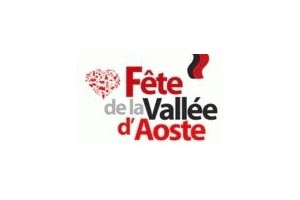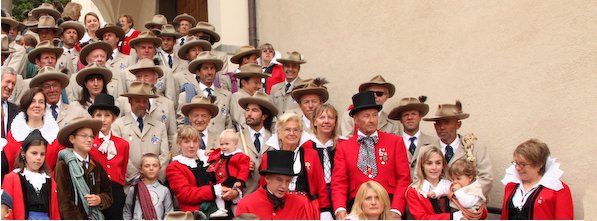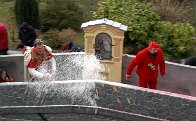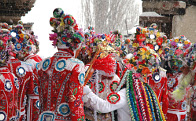Throughout the year the Valley hosts enchanting festivals, carnivals and wildlife events that attract visitors in their thousands.
The people of the Aosta Valley love to celebrate – which is why there’s a whole host of festivals, carnivals and wildlife events for visitors to enjoy. From witnessing the spectacular and dramatic Batailles de Reines to watching history unfold at various Veillà festivals and sampling tasty local delights, celebrations take place throughout the year and are always colourful and lots of fun for the thousands of spectators they attract.

VALLE D’AOSTA FESTIVAL
The Valle d’Aosta Festival was introduced in 2006, and its key moment is the awarding of two regional honorary awards. The first, Amis de la Vallée d’Aoste, confers honorary regional citizenship to an Italian or foreign person who has increased the prestige of the region. The second, Chevalier de l’Autonomie, is granted to Valle d’Aosta citizens who stand out for a particular contribution to their sports, culture, science, art, economy, politics or social field. The festival also features art exhibitions, conjurers, mime artists, clowns, comics, jugglers and musicians; as well as a food and wine pavilion and a musical symphony concert.

ETROUBLES VEILLÀ FESTIVAL
The town and commune of Etroubles is on the via Francigena, the famous pilgrim route that once connected the British Isles to Roma. This medieval village of Etroubles has functioned as a small local capital, look-out and services centre since ancient times. Etroubles Veillà has been held in August each year since 1984. For one night, inhabitants revoke old customs and agricultural traditions, including the processing of fontina cheese, the threshing of wheat, sheep-breeding and the processing of wool; handicrafts; and a depiction of old social life (washerwomen at the fountain, morra players, smugglers and chimney-sweeps). Local restaurants lay on different specialities, and there’s lots of traditional live music and a masked parade.
There are also further Veillà festivals across the valley.

COGNE VEILLÀ FESTIVAL
Until a few decades ago, “veillà” get-togethers were an opportunity for social gatherings in small communities during the long winter nights. Gathering in the stable of one of the village families, members of the community would take care of small maintenance jobs on agricultural machinery while passing on the latest news and swapping village tales and legends. At a modern-day veillà, the professions once exercised at the long winter get-togethers are resurrected in the streets of the old village of Lillaz, including craftwork (wooden sculptures and tools, lace-work and wrought iron), wool spinning, wheat threshing and milk processing. Visitors can also sample traditional culinary products, and there are folklore and choral shows.

ARNAD VEILLÀ FESTIVAL
Once again, a celebration based on the old veillà social gatherings of the past. Once every two years the Arnad Veillà brings to life past lifestyles, professions and traditional crafts. This particular veillà festival sees Arnad’s inhabitants play an active part in the resurrection of the past along a historical path, within a stable, a winery and a castle, where visitors can witness the threshing of wheat, the peeling of dried chestnuts and the hackling of hemp fibres once used for weaving. Traditional products and local delicacies can also be sampled, including Arnad lard, seupé, mahishtra de grì, apple strudel and fiocca macchiata with ground coffee.

ALPINE GUIDES FESTIVAL
The Alpine Guide’s festival takes place in summer on 15 August, which coincide with the first successful ascent of the Monte Bianco by Jacques Balmat and Michel-Gabriel Paccard in 1876. The following year, Balmat once again conquered the mountain peak accompanied by the scientist, De Saussure, thus giving rise to the first guided ascents. But in reality, the first ascent can’t be dated with absolute precision and there are references from as early as the year 1000 of young villagers accompanying pilgrims over the most popular Alpine passes.
This festival is spread across several Valle d’Aosta towns and includes spectacular displays of mountain-climbing ability and rock-climbing techniques.

VERRÈS CARNIVAL
The story of the Lady of the Castle – “the friend of the people” – is re-enacted every year by the people of Verrès. The year was 1450 and Caterina di Challant and her consort came down to Verrès, escorted by a handful of armed guards. After lunch with the Reverendo Pietro di Chissé, they made their way to the main square in front of the church where everyone danced, including Caterina. A unanimous cry went up: “Vive Introd et Madame de Challant”. Now, every year, this feast is celebrated by the whole population of Verrès, who play the parts of the nobles. The carnival features a rich programme of events and costume parades, followed by a ball in the halls of the Castle that overlooks the town. The carnival climaxes with the main characters entering the town square to hear the town crier reciting the “Proclamation of the Citizenry” in a “strange but comic” ancient language.

PONT-SAINT-MARTIN CARNIVAL
This historical carnival recalls the defeat of the Salassi by the Romans and allows the past losers the possibility of a return match, in a “chariot race”, which pits the local population against the invaders. Another part of the Carnival takes its inspiration from the legend of the Nymph of the Lys, the mountain stream that crosses the town. According to the legend, she was indignant with the townspeople and swelled the stream, intending to destroy the town, but when she reached the Roman bridge she was persuaded by the people to relent and pass through without causing damage. On the evening of Shrove Tuesday, an effigy of the Devil is hung from the single arch of the bridge – which according to another legend was built by him – and is burnt in spectacular fashion.

THE COUMBA FREIDA CARNIVALS
This is a series of carnivals held in different locations in the Valle del Gran San Bernardo, which has earned the nickname of “Coumba Freida” due to the cold blasts that blow down through the valley. Held in February, this is the most unusual carnival in Valle d’Aosta, featuring traditional costumes that recall the passage of Napoleon’s soldiers here in May 1800. Another more imaginative account says that the carnival originated on the occasion, when two elderly simpletons got married in the town. The townspeople had decided to join in with the celebrations, but felt embarrassed at the idea of turning up at the church in their “Sunday best” and so decided to wear unusual clothes instead. Costumes are adorned with beads, sequins and small mirrors, wooden masks are worn, and revellers carry the hair of a horse’s tail in their hands – all said to help banish evil spirits.

BATAILLES DE REINES
This spectacular wildlife event attracts thousands of spectators every year and has become one of the most important events in the Valley. Crowds assemble on the terraces of the “Croix-Noire” arena in Aosta to witness a lively display that plays on the aggressive instinct inherent in certain Alpine breeds of cow (although no danger is posed to the animals). They take part in breath-taking battles to determine the hierarchy within the herd. Every Sunday from the end of March onwards (with a brief pause in June and July), when the herds are moved to mountain pastures, the “Queens” of the Valley confront each other in various arenas throughout the region. On average, 150 cows take part every year. The first four places in each category qualify for the regional grand final, where the Queen is chosen.

BATAILLES DE TCHEVRE
The success and enthusiasm that characterises the Bataille de Reines has encouraged the farmers who breed goats (“chevre” in patois, the dialect in Valle d’Aosta) to follow the same path. So, in 1981, a parallel event was organised: the Bataille de Tchevre, where the animals confront each other in bloodless battles. The goats are also split into categories according to their weight, and the organisation of the combats is just the same as for the reine. The winners are awarded the “chambis”, collars made with maple or walnut wood, which are hand-carved and equipped with a traditional bell.
